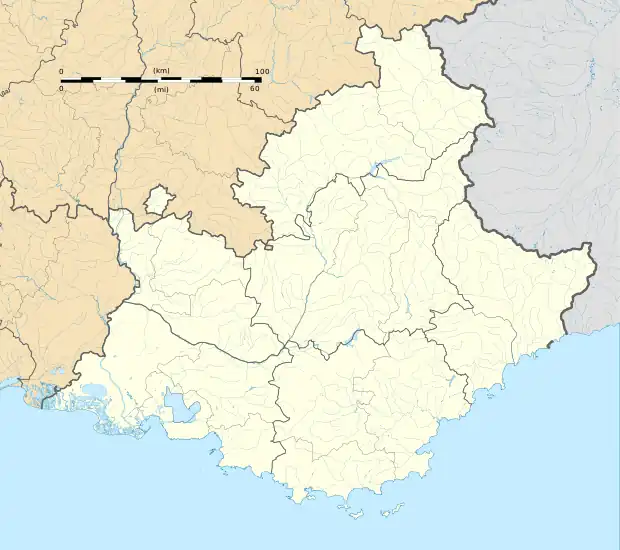Varages
Varages (French pronunciation: [vaʁaʒ]; Occitan: Varatge) is a commune in the Var department in the Provence-Alpes-Côte d'Azur region in southeastern France.
Varages | |
|---|---|
 The church of Our Lady of Nazareth | |
.svg.png.webp) Coat of arms | |
Location of Varages | |
 Varages  Varages | |
| Coordinates: 43°35′54″N 5°57′39″E | |
| Country | France |
| Region | Provence-Alpes-Côte d'Azur |
| Department | Var |
| Arrondissement | Brignoles |
| Canton | Saint-Maximin-la-Sainte-Baume |
| Government | |
| • Mayor (2020–2026) | Guy Partage[1] |
| Area 1 | 35.11 km2 (13.56 sq mi) |
| Population | 1,165 |
| • Density | 33/km2 (86/sq mi) |
| Time zone | UTC+01:00 (CET) |
| • Summer (DST) | UTC+02:00 (CEST) |
| INSEE/Postal code | 83145 /83670 |
| Elevation | 259–573 m (850–1,880 ft) (avg. 304 m or 997 ft) |
| 1 French Land Register data, which excludes lakes, ponds, glaciers > 1 km2 (0.386 sq mi or 247 acres) and river estuaries. | |
It is known for its vineyards and ceramic dinnerware.[3]
Geography
Climate
Varages has a hot-summer Mediterranean climate (Köppen climate classification Csa). The average annual temperature in Varages is 14.3 °C (57.7 °F). The average annual rainfall is 786.8 mm (30.98 in) with November as the wettest month. The temperatures are highest on average in July, at around 24.0 °C (75.2 °F), and lowest in January, at around 6.1 °C (43.0 °F). The highest temperature ever recorded in Varages was 44.5 °C (112.1 °F) on 28 June 2019; the coldest temperature ever recorded was −12.5 °C (9.5 °F) on 2 March 2005.
| Climate data for Varages (1991−2020 normals, extremes 1988−present) | |||||||||||||
|---|---|---|---|---|---|---|---|---|---|---|---|---|---|
| Month | Jan | Feb | Mar | Apr | May | Jun | Jul | Aug | Sep | Oct | Nov | Dec | Year |
| Record high °C (°F) | 22.4 (72.3) |
23.5 (74.3) |
28.0 (82.4) |
30.7 (87.3) |
33.9 (93.0) |
44.5 (112.1) |
40.4 (104.7) |
42.1 (107.8) |
35.4 (95.7) |
31.8 (89.2) |
24.6 (76.3) |
23.3 (73.9) |
44.5 (112.1) |
| Average high °C (°F) | 11.1 (52.0) |
12.7 (54.9) |
16.6 (61.9) |
19.5 (67.1) |
23.9 (75.0) |
28.7 (83.7) |
32.0 (89.6) |
31.9 (89.4) |
26.2 (79.2) |
20.6 (69.1) |
14.7 (58.5) |
11.3 (52.3) |
20.8 (69.4) |
| Daily mean °C (°F) | 6.1 (43.0) |
6.7 (44.1) |
10.0 (50.0) |
12.7 (54.9) |
17.0 (62.6) |
21.4 (70.5) |
24.0 (75.2) |
23.7 (74.7) |
19.1 (66.4) |
14.9 (58.8) |
9.7 (49.5) |
6.5 (43.7) |
14.3 (57.7) |
| Average low °C (°F) | 1.0 (33.8) |
0.7 (33.3) |
3.4 (38.1) |
5.9 (42.6) |
10.1 (50.2) |
14.1 (57.4) |
16.0 (60.8) |
15.6 (60.1) |
12.0 (53.6) |
9.2 (48.6) |
4.7 (40.5) |
1.7 (35.1) |
7.9 (46.2) |
| Record low °C (°F) | −9.2 (15.4) |
−10.6 (12.9) |
−12.5 (9.5) |
−5.3 (22.5) |
0.3 (32.5) |
5.4 (41.7) |
8.4 (47.1) |
7.6 (45.7) |
2.9 (37.2) |
−4.2 (24.4) |
−7.9 (17.8) |
−9.1 (15.6) |
−12.5 (9.5) |
| Average precipitation mm (inches) | 60.5 (2.38) |
42.2 (1.66) |
45.0 (1.77) |
75.1 (2.96) |
73.3 (2.89) |
55.4 (2.18) |
28.3 (1.11) |
37.9 (1.49) |
90.9 (3.58) |
96.0 (3.78) |
118.0 (4.65) |
64.2 (2.53) |
786.8 (30.98) |
| Average precipitation days (≥ 1.0 mm) | 5.8 | 5.5 | 5.7 | 7.6 | 6.5 | 4.6 | 2.8 | 3.7 | 5.5 | 6.9 | 8.5 | 6.7 | 69.9 |
| Source: Météo-France[4] | |||||||||||||
See also
References
- "Répertoire national des élus: les maires" (in French). data.gouv.fr, Plateforme ouverte des données publiques françaises. 13 September 2022.
- "Populations légales 2020". The National Institute of Statistics and Economic Studies. 29 December 2022.
- Michael Fox, Deborah Kaufman, and Alan Snitow, Thirst: Fighting the Corporate Theft of Our Water (Wiley_Default, 2007), 208.
- "Fiche Climatologique Statistiques 1991-2020 et records" (PDF) (in French). Météo-France. Retrieved September 15, 2022.
Wikimedia Commons has media related to Varages.
This article is issued from Wikipedia. The text is licensed under Creative Commons - Attribution - Sharealike. Additional terms may apply for the media files.